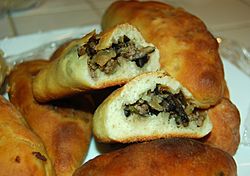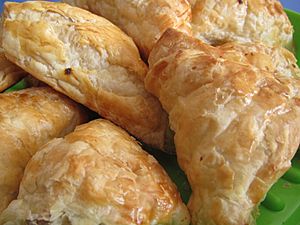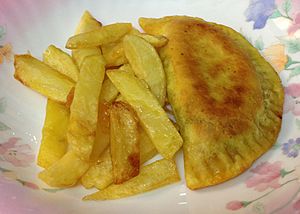Pirozhki facts for kids

Baked piroshki stuffed with meat, mushroom, rice and onions
|
|
| Alternative names | Piroshki, pyrizhky |
|---|---|
| Course | Appetizer, main, dessert |
| Place of origin | Russia |
| Serving temperature | Warm or hot |
| Main ingredients | Yeast dough, various fillings |
| Variations | Multiple |
Pirozhki (Russian: пирожки́, tr. pirožkí, IPA: [pʲɪrɐʂˈkʲi], plural form of pirozhok; Ukrainian: пиріжки, pyrizhky) are Russian and Ukrainian baked or fried yeast-leavened boat-shaped buns with a variety of fillings. Pirozhki are a popular street food and comfort food in Eastern Europe.
Contents
Terminology
The stress in pirozhki is on the last syllable: [pʲɪrɐʂˈkʲi]. Pirozhok (Russian: пирожо́к, tr. pirožók, IPA: [pʲɪrɐˈʐok], singular) is the diminutive form of Russian pirog, which means a full-sized pie. Pirozhki are not to be confused with the Polish pierogi (a cognate term), which are called varenyky in Ukrainian and Russian.
Variations
A typical pirozhok is boat- or rarely crescent-shaped, made of yeast-leavened dough, with filling completely enclosed. Similar Russian pastries (pirogs) of other shapes include coulibiac, kalitka, rasstegai, and vatrushka.
Pirozhki are either fried or baked. They come in sweet or savory varieties. Common savory fillings include ground meat, mashed potato, mushrooms, boiled egg with scallions, or cabbage. Typical sweet fillings are fruit (apple, cherry, apricot, lemon), jam, or quark.
Baked pirozhki may be glazed with egg to produce golden color. Also they may be decorated with strips of dough.
Pirozhki are usually hand-sized. A smaller version may be served with soups.
Regional varieties
The Americas
Varieties of pirozhki were brought to the Americas by Volga Germans. Known today as bierock, pirok or runza, they belong to several regional cuisines in the United States, Canada and Argentina. The populous Russian diaspora which came to the Americas as a consequence of the Russian Revolution and Civil War brought with them the more classic Russian versions of piroshki.
The Balkans
The Greek variety piroski (Greek: πιροσκί) is popular in parts of Greece, as brought by Pontic Greeks, and in most big cities, where they are sold as a type of fast food. The Greek piroskia come fried with many different stuffings.
In Serbia the local variety are cylindrical pastries called пирошка/piroška (piroshka). They are stuffed with fillings such as ground spiced meat mix of pork and veal or cottage cheese, and with kulen, tomato sauce and herbs. Alternatively they are made from breaded crepes with variety of fillings.
The Baltics
In Latvia crescent-shaped buns of leavened dough called speķrauši (literally, "fatback tarts") or speķa pīrāgi (often referred to in diminutive speķa pīrādziņi or colloquially simply pīrāgi or pīrādziņi) are traditionally filled with smoked fatback and onion. Other fillings are also possible. However the name pīrāgi is not exclusive to these buns, but can refer to variety of other pastries, such as pies and turnovers. Pīrāgi were often eaten as lunch by farmers and shepherds working the fields.
Estonians (and Finns) too have this tradition. The pirukad or saiakesed are fairly small in size and have regional variations in respect to fillings. They are usually made with puff pastry. Open pies covering the scale of whole baking tray are also popular, more similar to American pies. Many recipes exist, with meat, cabbage, carrots, rice, egg and other fillings and filling mixtures also being used. Sweet fillings are as popular as savory pirukad with fillings like apple, various berries, marzipan, various spices and jam.
South Caucasus
The Russian variant of pirozhki is a common fast food in Armenia and Azerbaijan. In Armenia it often contains a potato or seasoned meat filling. In Azerbaijan it is usually made with jam, mashed potatoes, or ground beef.
Central Asia
Pirozhki are common as fast food on the streets of the Central Asian countries in Kazakhstan, Tajikistan, Uzbekistan, Turkmenistan, Kyrgyzstan, Mongolia, where they were introduced by the Russians. They are also made by many Russians and non-Russians at home.
Finland
The Finnish version is the similar lihapiirakka, a popular street food made with donut dough, minced meat and rice.
Iran
The Iranian version, pirashki (Persian: پیراشکی pirāški), is often consumed as a dessert or as a street food. It is commonly filled with pastry cream, but potato and meat fillings are also available.
Japan
A Japanese version, called ピロシキ (piroshiki), are predominantly fried, use fillings such as ground meat, boiled egg, bean noodles, and spring onion, and are commonly breaded with panko before frying, in the manner of Japanese menchi-katsu. Another popular variation is filled with Japanese curry and is quite similar to karē-pan, which is itself said to be inspired by pirozhki.
Mongolia
Pirozhki is also very common as fast food in Mongolia, and it is made throughout the country by families at home.
See also
 In Spanish: Pirozhki para niños
In Spanish: Pirozhki para niños



